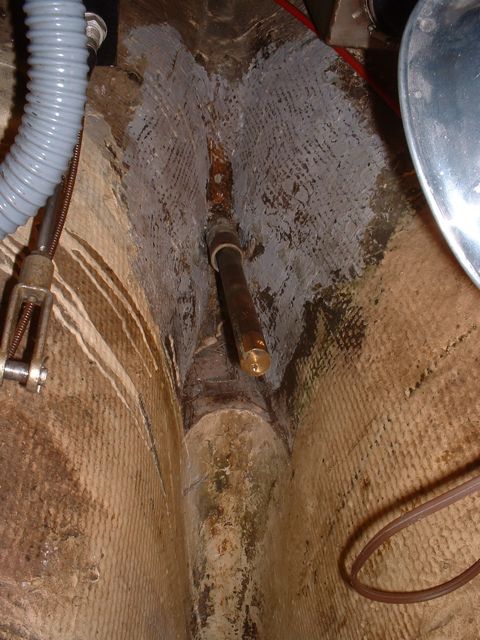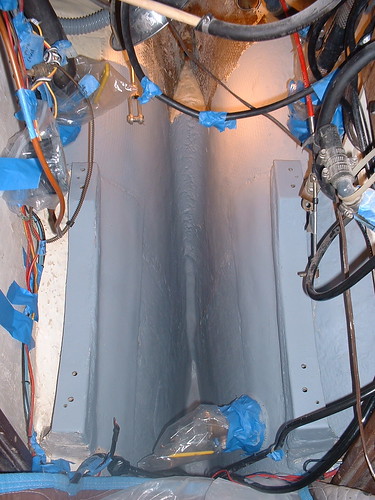Here is a bit of photo-description of work I did on my A-30 (1967 vintage).
This is inside the boat, looking back into the stern tube area of the boat when I first owned it.

The grey caulk is Thiokol (polysulfide I believe), which was put in by Whitby at build, from what I have read/heard from other owners. You can see it was hacked away slightly at some point in time, probably when a stuffing box hose was replaced in the past. I decided to explore (the hose was not far from failure, btw, and there was extra pressure put on the hose due to the size mismatch of the stuffing box and the stern tube - you can see where it is slightly "gathered" at the left side of the stern tube).
After scraping out a lot of Thiokol...

I had this:



If I'm remembering this correctly, there is a partial tube that is part of the "Moffitt" part, and then the rest of the stern tube threads into that, and is the hollow tube you see (the longer, solid item is the shaft, which was still in the tube when I took the photos).
As you can see, there are no visible nuts even with the caulking removed, so I suppose the stern tube fitting is probably lagged/screwed in, without nuts on the inside. I didn't mean to sound quite so negative on you removing it; I meant to imply that unless you had to remove it for some reason, well... maybe don't. But as Tim pointed out, it would probably not be a major issue to remove it (and maybe then you'd want to put in a fiberglass tube that wouldn't even have bedding?)
I remember reading a few posts wherein A-30 owners had started to remove the fitting, pulling it out and then (when it didn't come easily) describing how it kind of "snapped back" onto the deadwood. So it's probably bedded with something a bit elastic (at least on those boats).
At any rate, I had no reason to remove mine, as it was in good shape and there were no signs of corrosion or leaking, so I never tried. I had the engine and shaft out on the other side, so "plenty" of working room there (as long as your definition of "plenty" includes working hunched over and sitting on a short plank that straddles the engine beds).
That "shelf" you see below the tube is (or seemed to be) a big resin-and-some-glass pour that essentially just fills in the small triangular area at the after end of the keel. It extended down to the top of the "false" bilge filler. There were a few crazing type cracks on the top of it, so I covered it with thickened epoxy. After that I re-caulked it with polysulfide, although I did not extend the caulk out quite as far as Whitby did (I couldn't determine any reason for such a large area of filler). I cleaned off and painted the areas where I did not go back with caulk.

I don't have any photos of it after I re-caulked, but this one from during the painting process gives more of the overall picture of the "deadwood" area. The bottom 6" or so of what you see is normally buried in the "false" bilge - I got rid of that, and smoothed out the area where the deadwood "filler" ended about 6" shy of the bottom of the boat so that it would be smooth and paintable/cleanable.

Oh, and I think maybe we had a past thread wherein the subject of the original A-4 engine beds came up? You can see them in the above photo. I have read that they are not adequate for a diesel engine (due to the increased movement) and I would believe that. I could see them flexing under additional load (although they seemed fine for the A-4, and the obviously-old cutless bearing that came in the boat was not worn in an irregular fashion).
Okay, the stuffing box. From what I have read this is a standard Whitby feature: The diameter of the stern tube (at least the part that comes into the boat) does not match the stuffing box, and to top it off is an odd size (I think it was about 1-5/16" OD). The stuffing box, again if I recall correctly, was about 1-1/2" (maybe 1-7/16" - it was a slightly rough casting). So a piece of hose that would fit over the stuffing box was rather baggy on the stern tube.
Since there was plenty of extra material on the stuffing box barb (indeed, it was a bit irregular), I machined it down to 1-3/8". I chose that size as it was an available hose size, and would get it to within about 1/16" of the stern tube.
One note is that I could not find that size in "official," 5-ply stuffing box hose, such as that made by Buck Algonquin. Instead I went with a premium, heavy duty, wet-exhaust hose. In my case it was quite short anyway, so seemed more than adequate. I think I remember reading the fine print later and discovering the the smallest sizes of "real" 5-ply stuffing box hose were actually only 3-ply anyway -- I'll have to check on that. As you can tell, a few of the details are a bit fuzzy.
Here is the stuffing box post-machining:

As you can see in this photo, there was still plenty of meat on it:

Changing gears, here is the stern tube fitting on the outside. This is with the new cutless bearing in place:


As I mentioned, I think it was an "Apex" size (Duramax/cutless brand), although there is the chance it was an "Acid." (The brand with the fish names is easier to remember - Acid and Apex are too similar!)
Just let me know if I can (try to) answer any other questions or provide more detail.
Rachel















